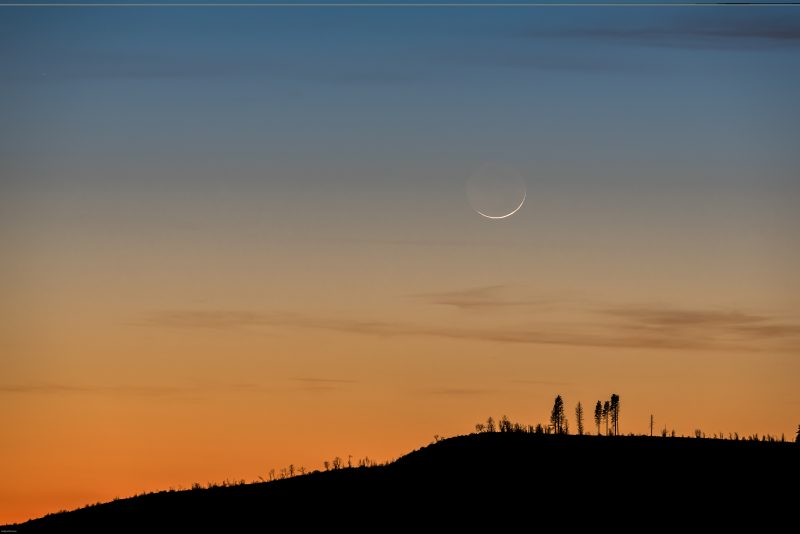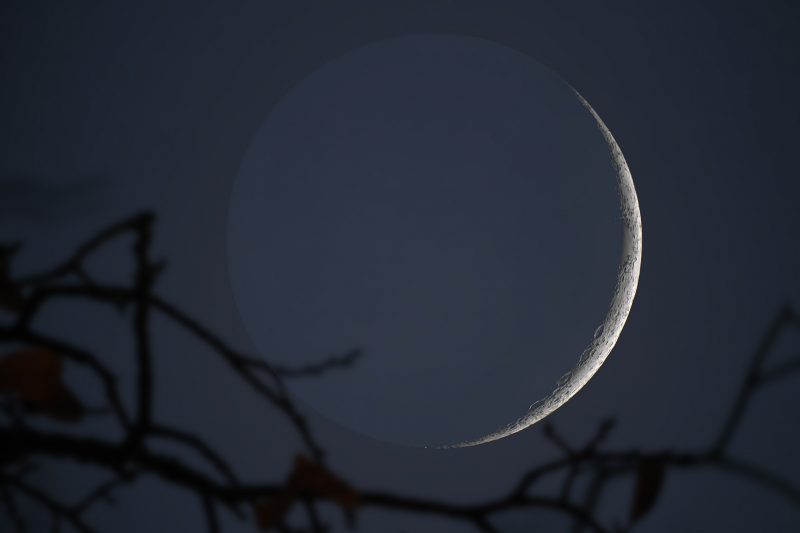

View larger. | A waxing crescent moon setting over the Twin Lights of Navesink, Highlands, New Jersey. (2.2% illumination) via Steve Scanlon Photography. Astronomers call it a young moon.
In the day or so after new moon, a waxing crescent moon appears in the west shortly after sunset.
Some people think a moon visible in the west after sunset is a rising moon. It’s not; it’s a setting moon. As Earth spins under the sky, all sky objects rise in the east and set in the west. A waxing crescent moon – visible in the western sky – follows the sun below the western horizon.
A waxing crescent moon has nothing to do with Earth’s shadow on the moon. Earth’s shadow can fall on the moon only at full moon, during a lunar eclipse. There is a shadow on a crescent moon, but it’s the moon’s own shadow. Night on the moon happens on the part of the moon submerged in the moon’s own shadow. Likewise, night on Earth happens on the part of Earth submerged in Earth’s own shadow.
What many think is Earth’s shadow on a crescent moon is really something else. It’s earthshine, the pale glow on the darkened portion (night side) of a crescent moon. It’s caused by light reflected from Earth’s day side onto the moon. After all, when you see a crescent moon in Earth’s sky, any moon people looking back at our world would see a nearly full Earth. Read more: What is earthshine?
Because the waxing crescent moon is nearly on a line with the Earth and sun, its illuminated hemisphere – or day side – is facing mostly away from us. We see only a slender fraction of the day side: a crescent moon. Each evening, because the moon is moving eastward in orbit around Earth, the moon appears farther from the sunset glare. It is moving farther from the Earth-sun line in space. Each evening, as the moon’s orbital motion carries it away from the Earth-sun line, we see more of the moon’s day side. Thus the crescent in the west after sunset appears to wax, or grow fatter each evening.
As the moon orbits Earth, it changes phase in an orderly way. Follow the link below to understand the phases of the moon.
New moon
Waxing crescent moon
First quarter moon
Waxing gibbous moon
Full moon
Waning gibbous moon
Last quarter moon
Waning crescent moon
Read more: 4 keys to understanding moon phases

A very young moon – a waxing crescent, soon to follow the sun below the western horizon – from Kelly Thomas in Hetch, Hetchy California. Thank you, Kelly.
Bottom line: A waxing crescent moon is up in the west after sunset. It’s waxing toward first quarter moon, which will come next on September 16, 2018, and full moon, which will come on September 24-25.
Check out EarthSky’s guide to the bright planets.
Help EarthSky keep going! Please donate.
from EarthSky https://ift.tt/1trITpz


View larger. | A waxing crescent moon setting over the Twin Lights of Navesink, Highlands, New Jersey. (2.2% illumination) via Steve Scanlon Photography. Astronomers call it a young moon.
In the day or so after new moon, a waxing crescent moon appears in the west shortly after sunset.
Some people think a moon visible in the west after sunset is a rising moon. It’s not; it’s a setting moon. As Earth spins under the sky, all sky objects rise in the east and set in the west. A waxing crescent moon – visible in the western sky – follows the sun below the western horizon.
A waxing crescent moon has nothing to do with Earth’s shadow on the moon. Earth’s shadow can fall on the moon only at full moon, during a lunar eclipse. There is a shadow on a crescent moon, but it’s the moon’s own shadow. Night on the moon happens on the part of the moon submerged in the moon’s own shadow. Likewise, night on Earth happens on the part of Earth submerged in Earth’s own shadow.
What many think is Earth’s shadow on a crescent moon is really something else. It’s earthshine, the pale glow on the darkened portion (night side) of a crescent moon. It’s caused by light reflected from Earth’s day side onto the moon. After all, when you see a crescent moon in Earth’s sky, any moon people looking back at our world would see a nearly full Earth. Read more: What is earthshine?
Because the waxing crescent moon is nearly on a line with the Earth and sun, its illuminated hemisphere – or day side – is facing mostly away from us. We see only a slender fraction of the day side: a crescent moon. Each evening, because the moon is moving eastward in orbit around Earth, the moon appears farther from the sunset glare. It is moving farther from the Earth-sun line in space. Each evening, as the moon’s orbital motion carries it away from the Earth-sun line, we see more of the moon’s day side. Thus the crescent in the west after sunset appears to wax, or grow fatter each evening.
As the moon orbits Earth, it changes phase in an orderly way. Follow the link below to understand the phases of the moon.
New moon
Waxing crescent moon
First quarter moon
Waxing gibbous moon
Full moon
Waning gibbous moon
Last quarter moon
Waning crescent moon
Read more: 4 keys to understanding moon phases

A very young moon – a waxing crescent, soon to follow the sun below the western horizon – from Kelly Thomas in Hetch, Hetchy California. Thank you, Kelly.
Bottom line: A waxing crescent moon is up in the west after sunset. It’s waxing toward first quarter moon, which will come next on September 16, 2018, and full moon, which will come on September 24-25.
Check out EarthSky’s guide to the bright planets.
Help EarthSky keep going! Please donate.
from EarthSky https://ift.tt/1trITpz


Aucun commentaire:
Enregistrer un commentaire